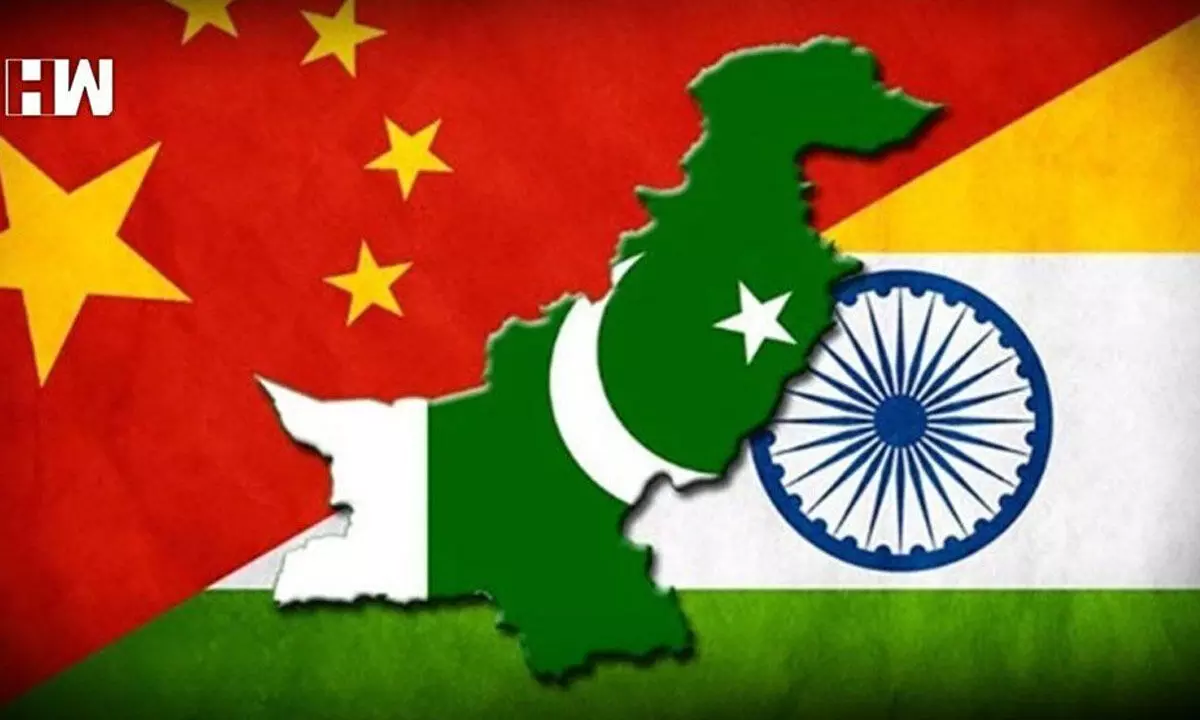Countering threat from prime adversary

Xi’s rise to power in China now matches that of Mao Zedong and his definition of Chinese ideology as ‘Marxism with Chinese characteristics’ is part of “Xi’s Thought” put in the party’s constitution.
It is now well established that China has – with the Sino-Pak axis bolstering its threat potential – emerged as the source of a lasting danger for India’s defence and security and for that reason alone that country needed to be studied in depth on a continual basis from the angles of ideology that governs it, the philosophy that guides its military growth and the advance it is striving to achieve in the sphere of technology of combat.
From what appears in the public domain by way of its proclaimed objectives, President Xi Jinping’s China has been following the strategy of gaining ‘civil-military fusion’, total supremacy of the Chinese Communist Party (CCP) and a steady push towards becoming the second superpower through the economic and technological route – apart from pursuing the path of a defence build-up.
Xi’s rise to power in China now matches that of Mao Zedong and his definition of Chinese ideology as ‘Marxism with Chinese characteristics’ is part of “Xi’s Thought” put in the party’s constitution.
It is a matter of great satisfaction that India is putting a comprehensive strategy in place for countering the threat from China and in a multi-prong response concentrating on measures to deal with the adversary on land and sea as well as in the air- through the development of missile and drone technology.
Indo-US relations are being constantly upgraded in the context of a new Cold War appearing on the horizon between the US and China and India is also successfully opposing the Chinese designs at international forums while assuming an active profile on a multilateral platform like Quad, in association with the US.
In a Marxist state, the released party documents tell a lot about which way the country was proceeding and these have to be closely studied and analysed. Cyber warfare and the use of social media as an instrument of combat come naturally to China as they fit in with the Marxist maxim of ‘winning a war without a battle’ and so does the thesis of ‘two steps forward one step backwards’ that was designed to get away with ‘salami slicing’ which was likely to be practised by the adversary on our borders.
Since May 2020, the Chinese troops have engaged in aggressive activities and precipitated skirmishes along the Sino-Indian border.
India has done well in the regime of Prime Minister Narendra Modi to carry out the necessary military build-up along the India-China border, particularly in Eastern Ladakh and Arunachal Pradesh and also push forward the civilian settlements there to match the Chinese activities along LAC.
China has managed to have an ingress in Afghanistan because of Pakistan’s initiative in arranging a ‘give and take’ between the Taliban Emirate and the Marxist state and has also stepped up its political and economic bonding with India’s neighbours including Nepal, Bhutan, Bangladesh, Sri Lanka, Myanmar, and Maldives.
India has to safeguard its neighbourhood against China’s attempts to use these countries to create bases for anti-India activities. There is another emerging area of concern for India attributable to Sino-Pak collaboration. The unusually large civilian casualties of over 30,000 resulting in Gaza from the Israeli attacks and domestic developments like forced resignations of the Presidents of Harvard and Pennsylvania universities for permitting pro-Palestinian demonstrations on the campus, seemed to have compelled the White House to try to be politically correct by speaking up against Islamophobia.
Not unexpectedly, Pakistan and China co-sponsored on March 15 a draft resolution in the UN General Assembly on ‘measures to combat Islamophobia’, which was passed with 115 nations including both the US and Russia supporting it, no member expressing its opposition and 44 countries including India, Brazil, Ukraine and a number of European countries like UK, France, Germany and Italy, abstaining from voting.
Pakistan was representing the Organisation of Islamic Conference (OIC) – the 57-member block of Muslim countries chaired by Saudi Arabia. India rightly took the stand that all acts motivated by anti-Semitism, Christianophobia or Islamophobia should be condemned and faiths other than Abrahamic religions should also be brought under the purview of the resolution. India pointed out that anti-Hindu, anti-Buddhist and anti-Sikh sentiments had also surfaced internationally.
Indian representative strongly advised the UN to maintain itself above such faith-related matters as this otherwise would have the effect of dividing the world body into “religious camps”. The move of Pakistan and China at the UN confirms the strategic strength of the Sino-Pak axis and reminds India of its adverse potential for this country.
There has been considerable criticism in Pakistan of the announcement of the implementation of the Citizenship Amendment Act (CAA) by India which was meant for accommodating the non-Muslim minorities persecuted in the three Islamic countries in India’s neighbourhood – Pakistan, Bangladesh and Afghanistan.
The Pak-sponsored resolution in UNGA was aimed, on one hand, at defending Islam against the implicit criticism of Sharia-ruled states for the unequal status accorded to non-Muslims by them and running down India, on the other, for the alleged suppression of Muslim minority in this country.
Introducing the resolution in the UN General Assembly, Munir Akram, Permanent Representative of Pakistan at the UN, referred without naming India, to the lynching of Muslims by cow vigilantes as well as the attacks on women wearing the ‘hijab’ and particularly denounced the act of “gleefully consecrating a Hindu temple on the ruins of a historical 500 years old mosque”.
It appeared that UN Secretary-General Antonio Guterres and the US were on the same side of the fence -- in believing that there is a rising trend of anti-Muslim hate reflected in unequal immigration policies, profiling and restrictions placed on Muslims in according citizenship to them, in many parts of the world.
The democratic world however, should be aware that it is Islam that claimed supremacism of faith on the ground that it was declared as the only ‘perfect’ religion -- which also happened to be the last -- and did not place other religions on an equal footing.
The US wants to keep its hold in the Middle East and for that reason consistently stands by its old friends Saudi Arabia and UAE. It should, however, be fully cognisant of the fact that in the wake of the ‘war on terror’, the hold of Islamic radicals had become stronger in the Muslim world creating a divide between the ‘radicalised’ countries hostile to the US-led West and those in deep friendship with the US. The former carries the historical legacy of the Nineteenth century Wahhabi Jehad that was directed against the European colonial powers in Algeria, Arabia and India -- this could be one reason why countries like the UK and France unlike the US, abstained from voting on the Pak-sponsored resolution against Islamophobia moved in UNGA.
India has to watch out for hostile lobbies pushing ahead with their propaganda on Muslim issues on the lines of the UN verdict.
The US policymakers would do well not to let any manoeuvrings of Pakistan or the influence of anti-India lobbies alleging unequal treatment of Muslim minorities in India, affect their better judgement. In the final analysis, there is no change in the security assessment that the Sino-Pak strategic alliance remains on top of the threats to India and requires a comprehensive handling in the spheres of defence, internal security and diplomacy.
Both Pakistan and China, it may be recalled, had joined hands in campaigning against India on the issue of Kashmir, particularly after the abrogation of Article 370 of the Constitution by the Indian Parliament in August 2019. India has to be extra vigilant against the ‘information warfare’ being run by the two hostile neighbours of India on the domestic matters of this country.
(The writer is former Director of the Intelligence Bureau. Views are personal)

















